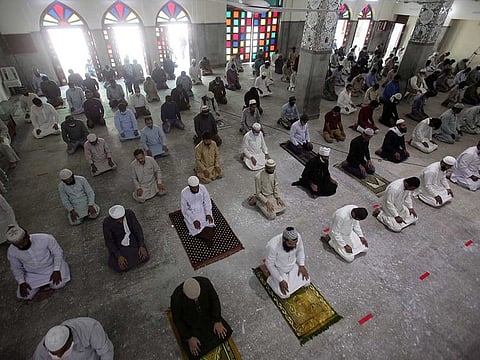Anxious Pakistanis wait for Covid-19 vaccine to arrive
Rising casualties and speedier infection rate has become an issue of national debate

Pakistan’s second-wave Covid-19 statistics are getting grimmer, but it is not in the grip of a national emergency. With a little over 8,000 deaths and 400,000 confirmed cases the country is 28 in the global list of infections. That its 2020 summer of comfort has been replaced by a winter of worry about rising casualties and speedier infection rate is an issue of national debate.
However, a more pressing concern for the public and the policymakers is about accessing the vaccine and the time frame within which the much sought-after wall of resistance to the pathogen can be found.
Since the British government rolled out the Pfizer vaccine and news has spread that the US, Canada, Malaysia, Japan, India and many European countries are getting ready for the introducing the antidotes to their population, public expectations and anxiety is growing about the medicinal miracle’s arrival in Pakistan.
Doctors and nurses are keen to find out about the government strategy to get the vaccine since they have been at the forefront of fighting a tough war against a deadly virus. Over 150 professional health specialists have lost their lives on account of Corona. Infections among the staff are in the thousands. The government has provided some broad answers. Its best foot forward has been its engagement with the Global Alliance (Gavi) to access the vaccine.
Also Read: Pakistan braces for a post-Trump era
Also Read: When cricket warms Pakistan’s heart
The initiative has been launched by the World Health Organisation along with the European Commission and France to ensure that there is equitable access to the vaccines and that resource-starved countries are not left behind in the struggle to get their populations immunised. So COVAX that aims to get around 2 billion doses available for front-line workers and lower-income countries is where the government points to when asked about the long-term solutions to the deadly challenge of Covid-19.
That is full of potential but not completely reassuring for those who think that the country should have a bilateral deal with vaccine makers and not wait for the global supply chains to start distributing it for free. That it is a costly business — at 32 dollars a person it is nearly 3 billion dollars for half of the country’s population. The COVAX platform speaks about 2021 for provision of vaccines. It does not talk about specific months. Then vaccines themselves can be tricky customers to handle.
A resource-intensive vaccine
Take the Pfizer vaccine for example. Its box is a scientific marvel that comes with a GPS tracker and a thermo monitor. The box can be opened only two times a day for 60 to 90 seconds each time. The bottles containing the vaccines have to be allowed to thaw for about half an hour to be ready and then after two hours of dilution can be administered in a span of six hours.
The bottles are wrapped in dry ice wrapper, which has to be replaced every five days. The vaccine trays in a box have five thousand dosages which have to administered twice twenty-one days apart without which it will not be effective.
This is a resource-intensive and management-savvy challenge that even the world’s most sophisticated systems may find hard. It involves the kind of logistical mobilisation, coordination and synchronisation that no country has carried out in modern times. All of government, all of the society and all of its leadership will have to gel into one to be able to get the vaccine across to the length and breadth of the country. Even less management-demanding vaccines will be a headache to deal with.
Pakistan’s experience with simple polio drops administration and their cold storage handling has been mixed. The cold chain logistics and vaccine management of routine immunisation have been found to be wanting in many ways. And this despite the fact that there are any number of internationally-endorsed good practices available that only need to be implemented to get the right kind of results.
A management complexity
For Covid-19 vaccine it is a management complexity of a different kind as each country will be taking on this task for the first time. Reaching out to the most vulnerable sections of society (the elderly and those above 50 years) in a descending order of priorities and then reverting back to the same set of people in less than four weeks would require a Herculean effort. The government says it is up for the challenge. The proof the resolve would, however, lie in the actual administration of the vaccine — when it arrives in the country.
In between the only practical respite that the public can look for is the return of the summer season, which in the first wave proved to be an efficacious natural antidote to the virus and at its peak reduced the prevalence to close to zero. That time is still some months away.
What is more the weatherman is reporting an EEW phase — Extreme and Extended Winter — in most parts of the country. With infections rising and little debate about the logistical arrangements for the population to be immunised once the antidote is obtained, one hopes that a bad situation does not take a turn for the worse.
— Syed Talat Hussain is a prominent Pakistani journalist and writer. Twitter: @TalatHussain12
Sign up for the Daily Briefing
Get the latest news and updates straight to your inbox







